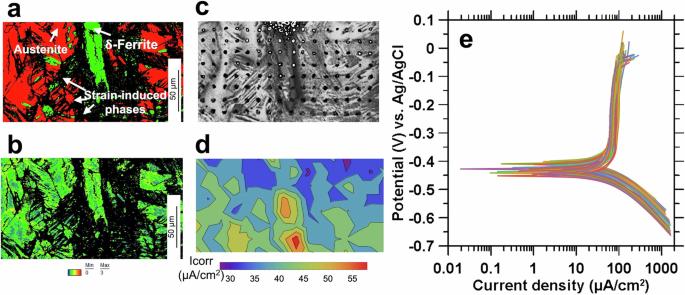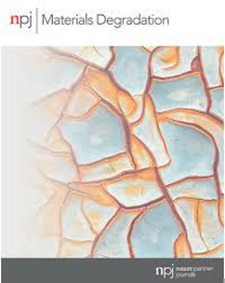核合金中机械和辐照诱发损伤的微结构解析电化学演化
IF 7.6
2区 材料科学
Q1 MATERIALS SCIENCE, MULTIDISCIPLINARY
引用次数: 0
摘要
需要进行高通量、规模相关和直接的电化学分析,以了解暴露在极端(高压、高温和辐照)环境中的核材料的腐蚀行为和敏感性。我们展示了扫描电化学电池显微镜 (SECCM) 的多尺度、多模式应用,以微观结构解析的方式对核合金的腐蚀变化进行电化学剖析。特别是,我们发现机械变形和辐照微结构都会降低电荷转移电阻,从而导致加速氧化。我们强调,机械变形和辐照的影响是协同的,实际上可能相互叠加,其影响包括一般、电化学和/或辐照激活的应力腐蚀开裂。综上所述,我们强调了非破坏性电化学检查的能力,以确定微观结构的改变如何导致核合金腐蚀倾向的变化:这些知识对核设施应用中合金的等级、资格和检查都有影响。本文章由计算机程序翻译,如有差异,请以英文原文为准。

Microstructurally resolved electrochemical evolution of mechanical- and irradiation-induced damage in nuclear alloys
There is a need for high-throughput, scale-relevant, and direct electrochemical analysis to understand the corrosion behavior and sensitivity of nuclear materials that are exposed to extreme (high pressure, temperature, and radiation exposure) environments. We demonstrate the multi-scale, multi-modal application of scanning electrochemical cell microscopy (SECCM) to electrochemically profile corrosion alterations in nuclear alloys in a microstructurally resolved manner. Particularly, we identify that both mechanically deformed and irradiated microstructures show reduced charge-transfer resistance that leads to accelerated oxidation. We highlight that the effects of mechanical deformation and irradiation are synergistic, and may in fact, superimpose each other, with implications including general-, galvanic-, and/or irradiation-activated stress-corrosion cracking. Taken together, we highlight the ability of non-destructive, electrochemical interrogations to ascertain how microstructural alterations result in changes in the corrosion tendency of a nuclear alloy: knowledge which has implications to rank, qualify and examine alloys for use in nuclear construction applications.
求助全文
通过发布文献求助,成功后即可免费获取论文全文。
去求助
来源期刊

npj Materials Degradation
MATERIALS SCIENCE, MULTIDISCIPLINARY-
CiteScore
7.80
自引率
7.80%
发文量
86
审稿时长
6 weeks
期刊介绍:
npj Materials Degradation considers basic and applied research that explores all aspects of the degradation of metallic and non-metallic materials. The journal broadly defines ‘materials degradation’ as a reduction in the ability of a material to perform its task in-service as a result of environmental exposure.
The journal covers a broad range of topics including but not limited to:
-Degradation of metals, glasses, minerals, polymers, ceramics, cements and composites in natural and engineered environments, as a result of various stimuli
-Computational and experimental studies of degradation mechanisms and kinetics
-Characterization of degradation by traditional and emerging techniques
-New approaches and technologies for enhancing resistance to degradation
-Inspection and monitoring techniques for materials in-service, such as sensing technologies
 求助内容:
求助内容: 应助结果提醒方式:
应助结果提醒方式:


